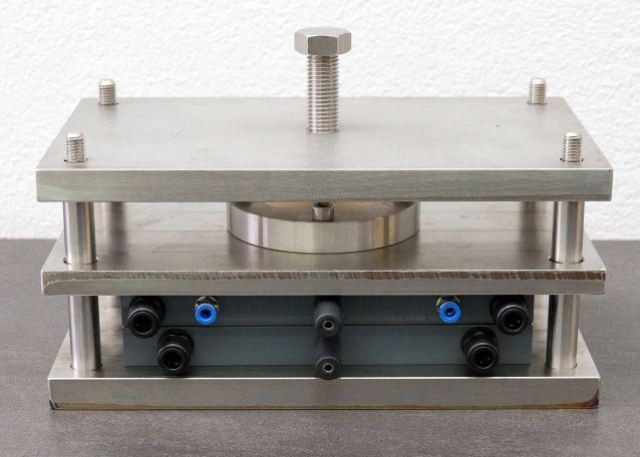May 31 2016
Extra power can be used for the decentralized production of chemicals so as to even out the spikes in power grids caused due to uneven regenerative energy conversion from sun or wind.
 In this electrolytic cell Fraunhofer researchers produce hydrogen peroxide with electricity for local use – just from air and water. (© Photo Fraunhofer IGB)
In this electrolytic cell Fraunhofer researchers produce hydrogen peroxide with electricity for local use – just from air and water. (© Photo Fraunhofer IGB)
A team of researchers from Fraunhofer IGB have created an electrolytic cell, where hydrogen peroxide can be manufactured on site using electric energy from air and water in conjunction with oxidative wastewater treatment. Between May 30 and June 3, 2016, the IGB team is showcasing a prototype electrolytic cell at the IFAT trade fair in Munich.
Hydrogen peroxide has high oxidization and cell toxic effects and therefore are used frequently as a disinfectant and bleaching agent in several technical areas, medical applications, and the production of cosmetics. For instance, in objectionable tooth discolorations, wood-colored pulp used to create white paper, or disinfecting work areas in food production and hospitals facilities. Hydrogen peroxide has also become definitely recognized in oxidative water treatment. In this case, under the effect of UV light, hydrogen peroxide forms hydroxyl radicals: these kill organic molecules which are not easily biodegradable.
Most of the time, hydrogen peroxide is manufactured on a large scale in centralized chemical plants, usually from hydrogen and oxygen and with a catalyst manufactured using platinum. Since hydrogen peroxide can decay spontaneously in extremely concentrated solutions and explode, it can only be transported as a dangerous substance subject to stringent safety measures. This in turn greatly increases the shipping costs.
The Fraunhofer Institute for Interfacial Engineering and Biotechnology IGB has created and implemented a novel technical concept where hydrogen peroxide is produced locally and based on demand in an electrochemical cell, which means using electricity alone – from water and air. As an effect of the turnaround in energy policy, there are uneven spikes in current supply from the regenerative energy production. As a result, the electrolytic manufacture of chemicals is getting economical and signifies a realistic utilization pathway for equaling spikes in current supply to the grid – in addition to energy storage.
Flexible synthesis in an electrolytic cell
The main component of the development is a flat electrolytic cell. When electric current flows, water is oxidized at the anode: protons are developed and the pH value reduces. At the same time, atmospheric oxygen is decreased at the cathode, a gas diffusion electrode, which is also used for instance in fuel cells. Consequently, the protons are consumed and hydrogen peroxide is produced.
In a first demonstrator with an electrode area measuring 100 sq.cm, the researchers accomplished concentrations of over 400 mg hydrogen peroxide per liter when pure oxygen was provided; when operating with surrounding air as the source of oxygen, concentrations of 50 mg hydrogen peroxide per liter was procured using an energy requirement of 10 kWh/kg H2O2.
In the meantime we have further optimized the system. We were able to increase the yield from 50 mg to 1200 mg hydrogen peroxide per liter when operating with air and thus achieved the same turnover as when operating with pure oxygen. Our system works without the use of chemicals. Additionally, our production of hydrogen peroxide is extremely flexible. When no surplus power is available, I simply switch off the electrolytic cell. Hydrogen peroxide that is not required immediately can be stored in a buffer tank and used as required.
Dr. Thomas Scherer, Group Manager, Fraunhofer IGB
Modular and scalable prototype
The novel electrolytic cell is operated as a flow-through cell. For conversion to an industrially applicable scale, additional cells can be linked in series or in parallel.
Individual electrolytic cells can also be stacked, for example as in fuel cell stacks. Such installations can then be designed on the basis of technical requirements and adjusted to the demand for hydrogen peroxide.
Dr. Thomas Scherer, Group Manager, Fraunhofer IGB
For other application-precise optimizations and developments, the method parameters can be altered and subcomponents in the demonstrator, such as the gas diffusion electrode, can simply be swapped. By modifying the temperature, volume flow, current density, and the composition of the solution, the pH value and the concentration of the solution can be adapted individually.
Proven operation in water purification
The decentralized electrolytic creation of hydrogen peroxide has already been effectively illustrated in the water treatment. In a research project financially supported by the European Union, oxidative treatment with locally produced hydrogen peroxide was integrated, in a single treatment step, with adsorptive elimination of contaminants from landfill leachate.
Going forward, the team plans to extend the industrial applications where only small consumption volumes are needed, for instance the hygienization of machines and plants in the food sector or surface disinfection in hospitals. For this reason, the researchers are on the lookout for interested partners to promote the applications.